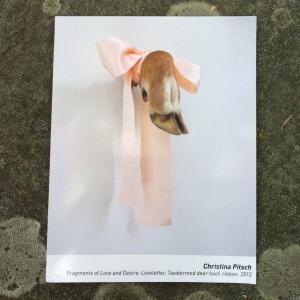
Last week, I met with Al Miner at the Museum of Fine Arts, Boston, where he works as Assistant Curator of Contemporary Art. He curated our current exhibition, All Natural, featuring Kingston member artists Kathleen Gerdon Archer, Mary Lang, Greg Lookerse, and Christina Pitsch. Each artist examines humankind’s attempts to commune with, control, or contain nature. The exhibition includes a broad representation of media, including photography, sculpture, and performance.

It didn’t take long for me to see that, although Miner says he’s not obsessed with landscape, it holds some fascination for him and, well, for all of us. “It’s a theme that clearly spoke to artists throughout time,” Miner said. Landscape paintings are among the most popular works in the Museum, he said, which is part of why he curated the long-term exhibition, Landscape, Abstracted, on view from August 2014 through July 2017. It includes an immense (24 x 80 feet) mural by Jason Middlebrook that Miner says has become “selfie central.” The point of the exhibition, he said, was to give examples of how artists today are not bound by the same constrictions as artists were in the past. There are so many contemporary takes on landscape, and artworks including Jason Middlebrook’s mural, green chenille beanbag “Topia Chairs” by Barbara Gallucci, and a site-specific installation made with thread and staples by Anne Lindberg demonstrate just how far they can abstract nature. They use color and pattern, among other visual tactics, to respond to the museum’s architecture, while simultaneously evoking nature and seizing upon natural phenomena.
When I inquired about Miner’s own interactions with nature and how they might influence his thinking he said, “I’m curious about whether anything real still exists,” Miner said. He does not want to camp, hike, or otherwise immerse himself in the outdoors. Really, he just wants sit outside at a cafe with a beverage and a piece of cake in the sunshine. That still feels like an authentic outdoor experience, especially if you’ve previously been in a windowless space and/or staring at a computer screen before arriving at said cafe.
“With this group of artists at Kingston,” Miner said, “I found that all four artists were making compelling and consistent bodies of work.” From there, he realized that all four of them dealt with nature, but with boundaries, compromises, and constructs.

Kathleen Gerdon Archer employs alchemy (turning water into ice, then ice back into water), using her own power to transfer elements from one state into another state.
Mary Lang compares dioramas of state parks with actual state parks. First, there is the issue of the gates, stairs, and other fixtures that may be meant to protect the park, but also alter the original landscape. Then there is the contrast of being intrigued by a real place, but realizing it isn’t real.
Greg Lookerse’s performance, Two Fish Cut Into Five Thousand Pieces, exaggerates the rules and constructs we follow when we interact with nature. Photographs documenting the performance are part of the exhibition, along with works from his Honey Storage series, where he folded cut paper from the book The Great American Forest, by Rutherford Platt, into honeycomb shapes. Lookerse, like Archer, alludes to the attraction of alchemy in his work.

Christina Pitsch created clear trophy mount deer heads with cast plastic, sewn vinyl, and sheet acrylic. “They become empty vessels, sucking out the meaning we expect from taxidermy,” said Miner. Pitsch employs her own clean and symmetrical aesthetic to interrogate why we hang something like a hunted and killed deer in an interior space.
Miner appreciated the depth and prolonged exploration evident in each artist’s work. Presented together, viewers become aware of the way all four artists manipulate natural elements, sometimes leading audiences in one conceptual direction, only to complicate our notions of this subject matter with an unexpected conclusion or eschewing one at all, but rather allowing nature’s mysteries to remain unsolved. They also remind us of how far we may have come from having a direct relationship with nature.

taxidermy deer hoof, ribbon, 19″ x 8″ x 7″
Miner is now working on a large group exhibition for the MFA entitled “Megacities Asia,” which examines the way artists in some of Asia’s most quickly expanding cities respond to the urbanization around them with found object practices. One thing that has become clear to him as he works with artists based in Seoul, Beijing, Shanghai, Mumbai and Delhi, is that, as he puts it, “being “green” is a luxury.” For instance, there is not yet a vibrant “green movement” in China. Citizens of Asian megacities experience natural spaces in more limited and different contexts, and, as the whole world is urbanizing at a staggering rate, we may soon experience nature this way ourselves. Will every city of the future incorporate green space? Is it and should it be important to every culture or not? Can they build green spaces indoors, or by maintaining a view of the horizon from the upper floors of a high-rise building reinforce a fading connection to the natural world? The artwork Miner included at Kingston raises these and other questions, too. Further, the MFA exhibition will be staged not only inside the Museum’s galleries, but also outdoors. Both exhibitions make it clear that contemporary conversations about landscape are as much about being human as about relating to nature.


2 Comments